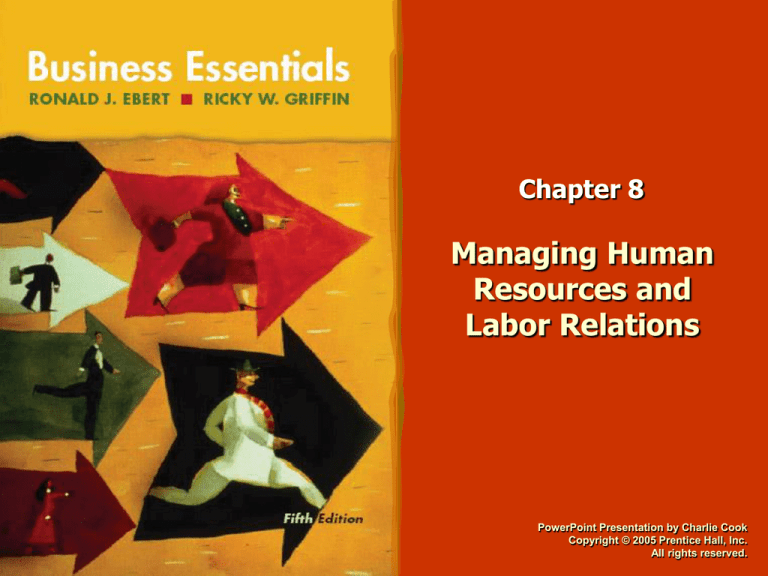
Chapter 8
Managing Human
Resources and
Labor Relations
PowerPoint Presentation by Charlie Cook
Copyright © 2005 Prentice Hall, Inc.
All rights reserved.
“Whenever you are asked if you can do
a job, tell 'em, ‘Certainly, I can!’ Then
get busy and find out how to do it.”
—Theodore Roosevelt
Copyright © 2005 Prentice Hall, Inc. All rights reserved.
8–2
Key Topics
• Human resource management
• Staffing, developing, and evaluating human
resources
• Compensation packages
• Legal issues in human resources
• Changes in the contemporary workplace
• Unionization and collective bargaining
Copyright © 2005 Prentice Hall, Inc. All rights reserved.
8–3
Human Resource Management
• Attracting, developing, and maintaining an
effective workforce—A critical, bottom-line
function!
Copyright © 2005 Prentice Hall, Inc. All rights reserved.
8–4
Job Analysis: Systematic Review of
Jobs Within a Firm
Job Description
Responsibilities and working conditions, plus
tools, materials and equipment to perform the job
Job Specification
Skills, abilities, and credentials needed to perform
the job
Copyright © 2005 Prentice Hall, Inc. All rights reserved.
8–5
Forecasting Labor Supply
• Internal Forecasting:
Replacement Charts
Skills Inventories
• External Forecasting:
State Employment
Commissions
Government Reports
College Information
Copyright © 2005 Prentice Hall, Inc. All rights reserved.
8–6
Managing a Projected Shortfall
• Hire new employees
• Consider hiring temporary workers
• Retrain and transfer current employees into
understaffed areas
• Convince older workers not to retire
The creative solution:
Develop and install productivity
enhancing systems
Copyright © 2005 Prentice Hall, Inc. All rights reserved.
8–7
Recruiting: Attracting Qualified
Candidates to Apply for a Job
• Internal Recruiting
Considering current
employees for new
positions
• External Recruiting
Attracting outside
candidates to apply
for jobs
What are the strengths and
weaknesses of each
approach?
Copyright © 2005 Prentice Hall, Inc. All rights reserved.
8–8
Selecting Human Resources
• Application Forms
• Tests
• Interviews
Validity
The predictive value of a selection technique
Copyright © 2005 Prentice Hall, Inc. All rights reserved.
8–9
Developing the Workforce
• Training
On-the-job training
Off-the-job training
Vestibule training
Performance Appraisal
Evaluating job performance
Copyright © 2005 Prentice Hall, Inc. All rights reserved.
8–10
Compensation and Benefits
• Wages
Money paid for time worked
• Salary
Money paid for accomplishing a specific job
Incentive Programs
Incentives
Money linked specifically
to high performance
Bonuses
Copyright © 2005 Prentice Hall, Inc. All rights reserved.
8–11
Benefits: Compensation Other Than
Wages and Salaries
• Optional Benefits
Retirement plans
Health, life, and disability insurance
Vacations and holidays
Counseling services
• Mandatory Benefits
Social security
Workers’ compensation
Copyright © 2005 Prentice Hall, Inc. All rights reserved.
8–12
Equal Opportunity:
Unfair Discrimination Is Illegal
• Equal Opportunity Laws
Protect workers from discrimination based on prejudice
• Protected Class
People with common characteristics as indicated by law
• EEOC
Federal agency that enforces discrimination-related laws
• Affirmative Action
Plan to hire and develop members of protected classes
Copyright © 2005 Prentice Hall, Inc. All rights reserved.
8–13
Contemporary Legal Issues in
Human Resource Management
• Employee safety and health
• AIDs in the workplace
• Sexual harassment
Quid pro quo
Hostile work environment
• Employment-at-will
Copyright © 2005 Prentice Hall, Inc. All rights reserved.
8–14
Managing Knowledge Workers
• Knowledge workers add value because of
what they know.
Computer Scientists
Physical Scientists
Engineers
Hiring and retaining
knowledge workers is a
critical HR challenge
Copyright © 2005 Prentice Hall, Inc. All rights reserved.
8–15
Contingent Workers: A Rapidly Growing
Trend
• Management challenges:
Careful
Planning
Understanding
Pros and Cons
Assessing
True Costs
Developing a
Management
Strategy
Copyright © 2005 Prentice Hall, Inc. All rights reserved.
8–16
Managing Organized Labor
• Labor Union
People working together to achieve shared jobrelated goals
Labor Relations
Managing unionized
employees
Copyright © 2005 Prentice Hall, Inc. All rights reserved.
8–17
Trends in Organized Labor
Union-Management
Relations
Bargaining
Perspectives
Future
Outlook
Copyright © 2005 Prentice Hall, Inc. All rights reserved.
8–18
Contract Issues
• Compensation
• Benefits
• Job Security
• Other Union Issues
• Management Rights
Copyright © 2005 Prentice Hall, Inc. All rights reserved.
8–19
When Bargaining Fails…
• Union Tactics:
Strike
Picketing
Boycott
Work slowdown
Copyright © 2005 Prentice Hall, Inc. All rights reserved.
• Management Tactics:
Lockouts
Strikebreakers
8–20
Resolving Disputes
Mediation
Voluntary Arbitration
Compulsory Arbitration
Copyright © 2005 Prentice Hall, Inc. All rights reserved.
8–21
Chapter Review
• Define human resource management
• Discuss staffing, developing human resources,
and evaluating performance
• Describe the role of compensation in attracting
and keeping skilled workers
• Identify the key legal issues surrounding human
resource management
Copyright © 2005 Prentice Hall, Inc. All rights reserved.
8–22
Chapter Review (cont’d)
• Discuss important changes in the contemporary
workplace
• Explain why workers unionize and discuss the
collective bargaining process
Copyright © 2005 Prentice Hall, Inc. All rights reserved.
8–23






